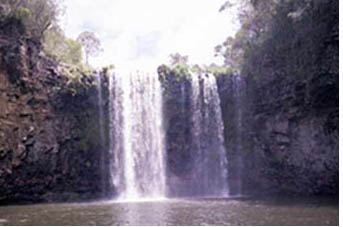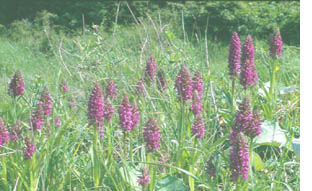 Utilities
Sector Case Studies Utilities
Sector Case Studies
Severn Trent Water
Severn Trent Water Limited, provider of water, waste and utility
services to the English Midlands and mid Wales launched a Biodiversity
Action Plan in 1999 in order to enhance the environmental condition
of their land-holdings.
Working with a wide range of partners throughout the
region, Severn Trent’s Biodiversity Action Plan has been contributing
significantly to the delivery of local and regional biodiversity
targets. In addition to helping wildlife, the BAP has helped the
company initiate operational improvements. For example, reed beds
which were constructed for tertiary sewage treatment resulted in
an increased population of the reed bunting, a species of high conservation
value, in the area. Implementing the BAP has helped Severn Trent
to meet the EU Freshwater Fish Directive and River Quality Objectives.
Other major components of the Biodiversity Action Plan include
environmental education and promotion of conservation. Staff training
raises awareness to biodiversity issues and provides employees with
guidance and skills on how to manage sites. Local communities and
staff participate in conservation volunteer days, on and off site,
learning about the opportunities for biodiversity enhancement.
Severn Trent promotes and reports on their actions and achievements,
hoping to encourage similar initiatives to be developed by others,
through annual CARE Reports (Conservation Access Recreation and
Education) and BAP Progress reports. They have also been awarded
a number of awards demonstrating and publicising their commitment
to biodiversity, examples include Living Wetlands RSPB 2003; Green
Apple 2004.
For more information on Severn Trent’s Biodiversity Action
Plan and activities click
here.
BNFL
As part of one of its environmental sustainability principles,
BNFL has made a public commitment to conserving biodiversity. This
is supported by a target to implement a Biodiversity Action Plans
at all of its UK Nuclear sites by the end of 2005/06. Implementation
of the plan is progressing well.
An example of the conservation activities which BNFL have initiated
is at the company’s Berkeley Site in Gloucestershire. The
company arranged for the South Gloucestershire Drainage Board to
modify the maintenance regime they undertake on the Conigre Pill,
a small watercourse, to protect the reed beds. Routine flood defence
work has been deferred until September each year, to allow whitethroats
and reed warblers to breed undisturbed. Also the decommissioning
of the disused Cooling Water structures for Berkeley Power Station
was managed to minimise the potential disruption to breeding birds
on the Severn Estuary.
BNFL also supports the commitment of staff members in carrying
out biodiversity initiatives. At the Risley office employees from
Nuclear Science and Technology Services, put up bat and bird boxes
and helped to clear birch trees encroaching on the edge of the local
Risley Moss Nature Reserve.
 Northumbrian
Water Northumbrian
Water
For several years Northumbrian Water have been working with the
Durham, Northumberland, Tees Valley, Essex, Suffolk, and Norfolk
Wildlife Trusts, and the Broads Authority to improve its company
sites and to promote conservation.
Following a consultation workshop in spring 2002, Northumbrian
Water developed a shared learning programme which enabled them to
work efficiently with biodiversity partners and to share expertise
and experience. The benefits of such work are of great importance
for both sides as the partnership provides valuable business skills,
such as customer service, strategy development and negotiating skills
for the conservation groups and in return it offers expertise on
the impacts of environmental legislation, practical conservation
skills and raising the environmental awareness to the company.
In the company's environmental policy, priorities issues are: risk
management aimed to reduce damage of sites with archaeological and
conservation importance; conservation surveys to identify key biological
species, such as dragonfly and bats; achieving BAP targets set for
8 habitats and 41 species; and sustainable agriculture with an emphasis
on water quality. A folder of further information is available from
the company on request.
 RWE
npower RWE
npower
RWE npower recognised the importance of biodiversity in the 1990's
and became one of the leaders in the industry to implement a company-wide
strategy to protect and improve biodiversity on its sites and in
the communities where the company operates. Site Biodiversity Action
Plans were prepared for Aberthaw in Wales and Fawley in Dorset.
Today the saline lagoon at Aberthaw boasts a variety of locally
and nationally important species such as bee orchids, purple gromwell
and the rare green flat worm species. Fawley is located among several
sites of recognised biodiversity importance and supports many rare
species and unusual habitats within its boundaries. A particular
feature of the site is the representation of transitional habitats,
from saltmarsh to vegetated shingle and from dry grassland to fen
and reedbed. Notable rare species of plant recorded on the site
include Annual Beard-grass, Divided Sedge and Little robin.
Just outside Didcot Power Station in Oxfordshire the company supported
the establishment of an environmental education centre at Sutton
Courtney Nature Reserve. At Little Barford Power Station in Cambridgeshire
the company has supported the Landscape 2000 scheme (which is linked
to Bedfordshire and Cambridgeshire Biodiversity Action Plans) for
over 10 years. The scheme’s projects aim to improve the quality
of the environment around St. Neots, Cambridgeshire, through working
with the local community to plant and restore trees and enhance
the quality of churchyards, ponds, parks and other green areas.
RWE npower was also the first company to support and sponsor the
Business and Biodiversity Resource Centre formulated to encourage
and provide information to companies about biodiversity conservation.
Scottish Power has developed a model for preparing Site Biodiversity
Action Plans which it now applies to all its large sites in the
UK. SP Generation UK, Scottish Power’s electricity generation
business, carried out comprehensive surveys of its sites, taking
stock of biodiversity as well as other environmental and operational
activities. Following a prioritisation exercise, sites at Galloway,
Cockenzie, Longannet and six of the Company’s hydro-electric
schemes along the Dee and Ken rivers began the process of preparing
Site Biodiversity Action Plans. Equally, SP Power Systems, the business
responsible for electricity transmission and distribution in Southern
Scotland, put together a Site BAP for the Townhill substation in
Fife.
These plans outline how the Company can positively enhance biodiversity
for the Company’s land holdings, some of which qualifies as
priority habitat under the UK and local BAPs. Each one is compiled
through cooperation with various local stakeholders, such as the
local biodiversity partnership, wildlife trust or rangers. Ultimately,
the Site BAPs are amalgamated into the Company’s overall Environmental
Management System for each site, thus mainstreaming the biodiversity
work into the sites’ overall operations.
Photo Credit:
Waterfall, Phillippa Arnott
Biodiversity Leaflet/Northumbrian Water
RWE npower, Southern Marsh Orchids
|




